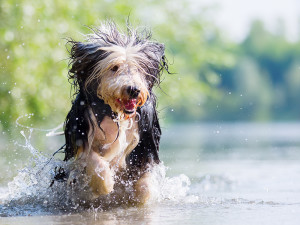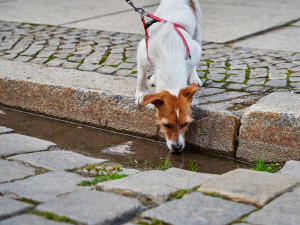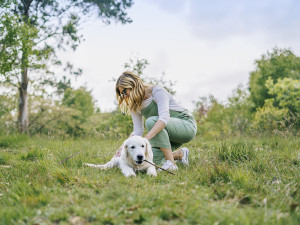You’ve Got a Summer-Lovin’ Pup. Here’s How to Keep Them Safe
Some like it hot (but not most dogs). Here are the season’s health hazards, from fleas to grass seeds

Share Article
After a long winter and allergy-rife spring, the arrival of summer months can feel like a relief. When those long days arrive, you and your dog are probably more than ready for some vitamin D. To help keep your dog safe in the season – so you can enjoy summer at its best – we asked veterinarian Dr Carla Lerum to weigh in on common hot weather hazards.
Heatstroke and dehydration
Just like people, dogs are at risk for heatstroke and dehydration when temperatures rise. How hot is too hot for your pup? “If you’re uncomfortable in the sun, your dog probably is, too,” says Dr Lerum. “Make sure your dog always has access to fresh water and shade when outside. You can also give them ice-filled Kongs or a frozen water bottle to keep them entertained and cool.”
It’s not just the air temperature you need to worry about. Hot surfaces can cause painful blisters on your dog’s paws. This is especially an issue in urban areas where you’re more likely to be walking your dog on the pavement than grass or dirt. According to Dr Lerum, if you can’t hold your hand to the ground comfortably for more than a few seconds, it’s too hot for your dog to walk on. “Try to take your pup out in the early morning or late evening when the temperatures are cooler. If that’s not an option, you can put booties on them to protect their paws.”
Some dog breeds, such as Pugs, Bulldogs, Boston Terriers and other flat-faced breeds have a particularly tough time in hot weather. Their restricted airways put them at greater risk for heatstroke and make them less tolerant of exercise. Keep an extra close eye on them during warm days and let them be a couch potato if it gets too hot.
Drowning and dry drowning
Summer also means swimming in lakes, floating down the river and trips to the beach. None of these activities are really complete without a wet dog shaking themselves dry on to you, so you’re going to want to bring your pup. Just keep a few safety tips in mind.
“Not all dogs like to swim and forcing your dog to try it isn’t going to encourage a positive association with that activity. Let them take it slow and get used to it at their own pace,” says Dr Lerum. “Even if a dog knows how to swim, they may not understand tides or currents, so it’s important for you, as the pet parent, to assess any risks and keep your pup out of the water if the conditions are dangerous. And whenever your dog is in an uncontrolled situation around water (like in a boat), make sure they are wearing a doggie life vest.”
Salt water poses a specific risk to dogs. While drinking a small amount of salt water will likely produce only mild, if any, symptoms, large amounts can be quite serious. Salt water can cause vomiting and diarrhoea and throw off a dog’s electrolyte balance. When a dog ingests toxic levels of salt water, it can lead to seizures, kidney problems and even death. Do your best to keep your dog from drinking any salt water while swimming or playing and seek immediate attention if your dog starts experiencing diarrhoea, weakness, tremors or seizures.
Also, be on the lookout for signs of water intoxication, aka dry drowning, which can take several hours or even days to appear. Dry drowning happens when a dog inhales water into their lungs, affecting their ability to breathe. Symptoms include coughing, wheezing, bluish gums and skin and extreme lethargy. If you spot any of these signs, take your dog to the vet immediately.
Lepto and Giardia
When you see a pool of cloudy, stagnant water, your first thought is probably ugh, grim. When your dog sees one, they are likely deciding which to do first – splash around in it or gulp it down to cool off. Both have the potential to make your dog (and possibly you) sick.
“Diseases such as leptospirosis and Giardia can be spread to dogs through contaminated water... and then to pet parents,” warns Dr Lerum. “Make sure your dog is up to date on their lepto vaccine. Unfortunately, there is no vaccine for Giardia so try to keep your dog away from any still or unclear water. And if you see signs of stomach upset, including particularly foul diarrhoea, a trip to the vet may be in order.” It’s worth noting that while lepto is rare in the UK, it’s still better to be safe (and vaccinated) than sorry.
Blue-green algae
Another big thing to watch out for is blue-green algaeopens in new tab, which can be extremely toxic to dogs. Before heading to a body of water, check the local news for any reports of algae blooms. Signs of algae poisoning in dogs include difficulty breathing, muscle weakness, lethargy and seizures. If you notice these or any other unusual symptoms after a trip to the water, contact your vet immediately as speedy treatment is critical.
Fleas and ticks
Protecting your dog from parasites is important all year, but warm weather and more time outside put your pup at even greater risk – unfortunately, fleas and ticks love hot summer days, too. Ticks can be found all over the UK, but high-risk places include grassy and wooded areas in southern and northern England and the Scottish Highlands. The Sheep Tick (or Castor Bean Tick) accounts for 71 percent of ticksopens in new tab affecting dogs in the UK and can pass on Lyme disease, babesiosis and anaplasmosis to our dogs.
Fleas and ticks aren’t the only summer parasite concerns. Mosquitoes are the uninvited guest at just about every outdoor gathering, and as if their bites weren’t bad enough, they also carry heartworm disease. Because the parasite requires high sustained temperatures to develop in the mosquito, heartworm is thankfully very rare in the UK. However, if you are travelling to hotter climes you need to be aware of the risk. A single bite from an infected mosquito can transmit heartworm disease to your dog – heartworms’ favourite host – which is serious and fatal if left untreated.
While heartworm disease can be a lengthy, expensive process to treat, preventing it is easy with consistent doses of a heartworm preventive. There are many options for heartworm and flea/tick control (and some that prevent all three at once), so talk to your vet about the best product for your pet if you are travelling to the Mediterranean.
Foxtails
Meadow foxtailopens in new tab is common throughout the UK, together with other grass seeds. These plants have barbed seed heads that can pose a big threat to dogs. Like, really big. Foxtails and other grass seeds can get lodged in the nose and then travel to your dog’s brain. They can get inhaled and puncture a lung. And they can burrow right through your dog’s skin and then travel anywhere in the body, causing swelling, abscesses and even death. Pretty scary stuff.
The best way to keep your dog safe is to avoid foxtails and similar plants altogether which you can find in meadows of wild grass. If that’s not possible, it’s a good idea to check your pup for foxtail seeds any time you think they’ve been exposed to them. (Pro tip: for especially furry pups, keep their feet shaved or trimmed so foxtails can’t hide in their hair.)
“I always recommend giving dogs a thorough once-over after they’ve been outdoors,” says Dr Lerum. “This will not only help you protect them from the dangers of foxtails, but also allow you to check them for ticks, cuts, paw damage or any other issues that may have occurred while they were out having fun.”
Fatigue
If you’ve ever started a workout routine from a fitness level of, let’s say, zero, you know that it’s... rough. The road to peak performance takes time. And while you may be more than ready to get back to the active lifestyle that winter put on pause, if your dog is your running buddy they may need some time to ramp up.
“Not only will they need to build back their endurance, but their paw pads might need time to redevelop the calluses that protect their feet on rougher terrain. It’s best to do a moderate, controlled re-entry to outdoor adventures.”
When in doubt, ask a vet
Anytime you have a change in lifestyle that involves your dog, it’s a good time to check in with your veterinarian. Maybe this is the summer you take up camping or go on a road trip. New adventures could mean new exposures for your pup. Your vet will be able to take this information and make any needed adjustments to your dog’s vaccines, parasite control or other proactive healthcare recommendations.

Kate Sheofsky
Kate Sheofsky hails from San Francisco, where she developed a love of writing, Giants baseball, and houses she can’t afford. She currently lives in Portland, OR, and works as a freelance writer and content strategist. When not typing away on her laptop, she enjoys tooling around the city with her two rescue pups searching for tasty food and sunny patios.
Related articles
![]()
Scared Stiff: How to Spot Tetanus in Dogs
Dogs can get tetanus, too – and not just from rusty nails
![kitten lying on the floor breathing through his mouth]()
Is My Cat... Panting?
“Cats don’t pant to cool off like dogs do.” Unless your pet is catching their breath after doing the zoomies, Dr Gary Weitzman says panting could be cause for concern
![Dog near a vegetable garden next to a basket full of a harvest]()
Tips on Dog-Safe Gardening
Garden organically, for the sake of both the planet and your dogs
![Dog drinking water from a puddle in the road]()
Giardia In Dogs: Signs, Symptoms and Treatment of This Summer Parasite
If your dog drinks from puddles or splashes around in streams, read this







